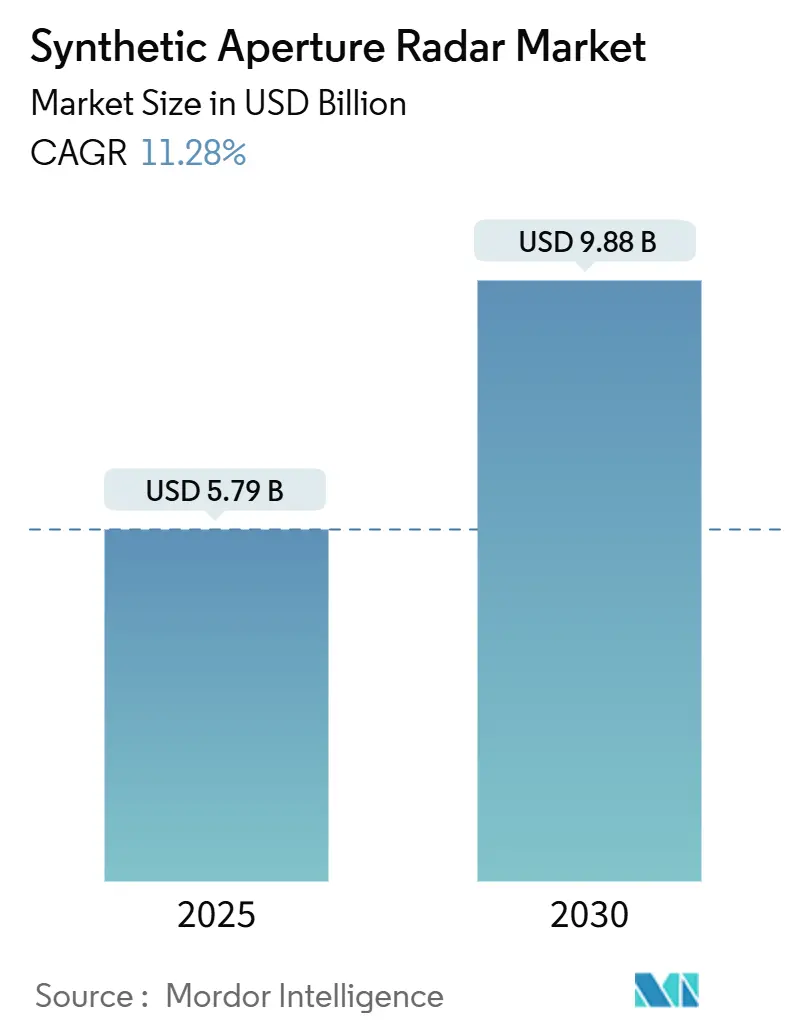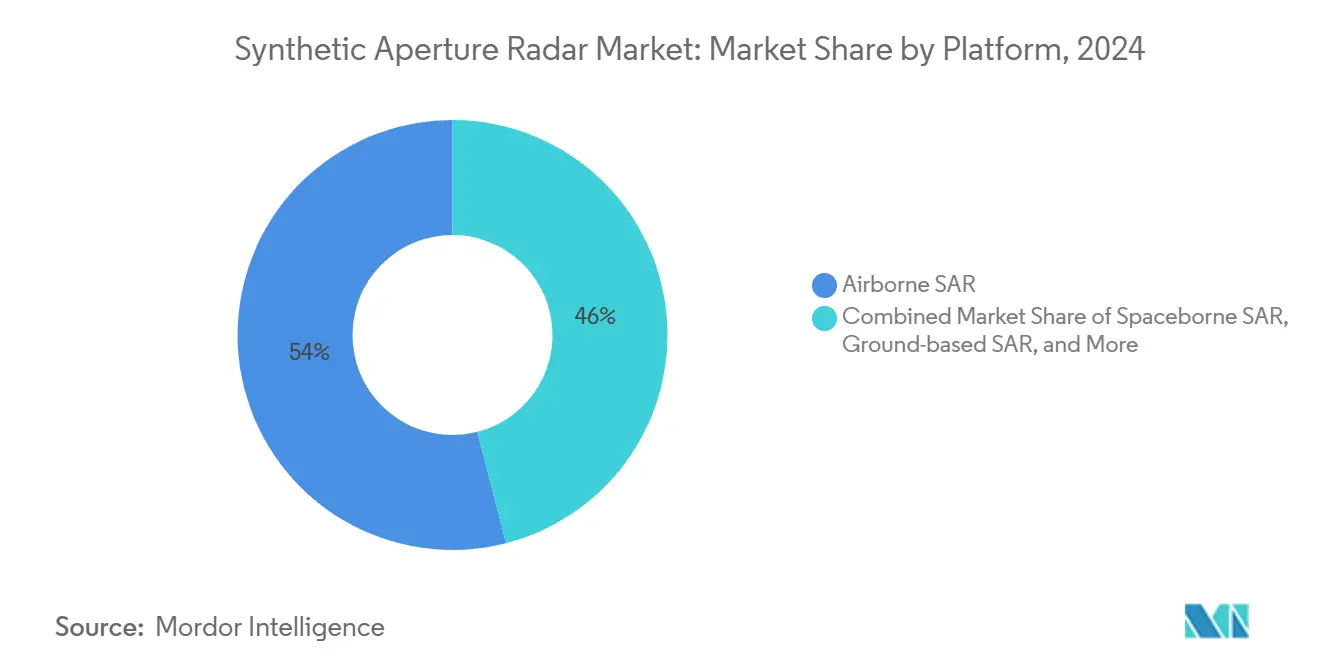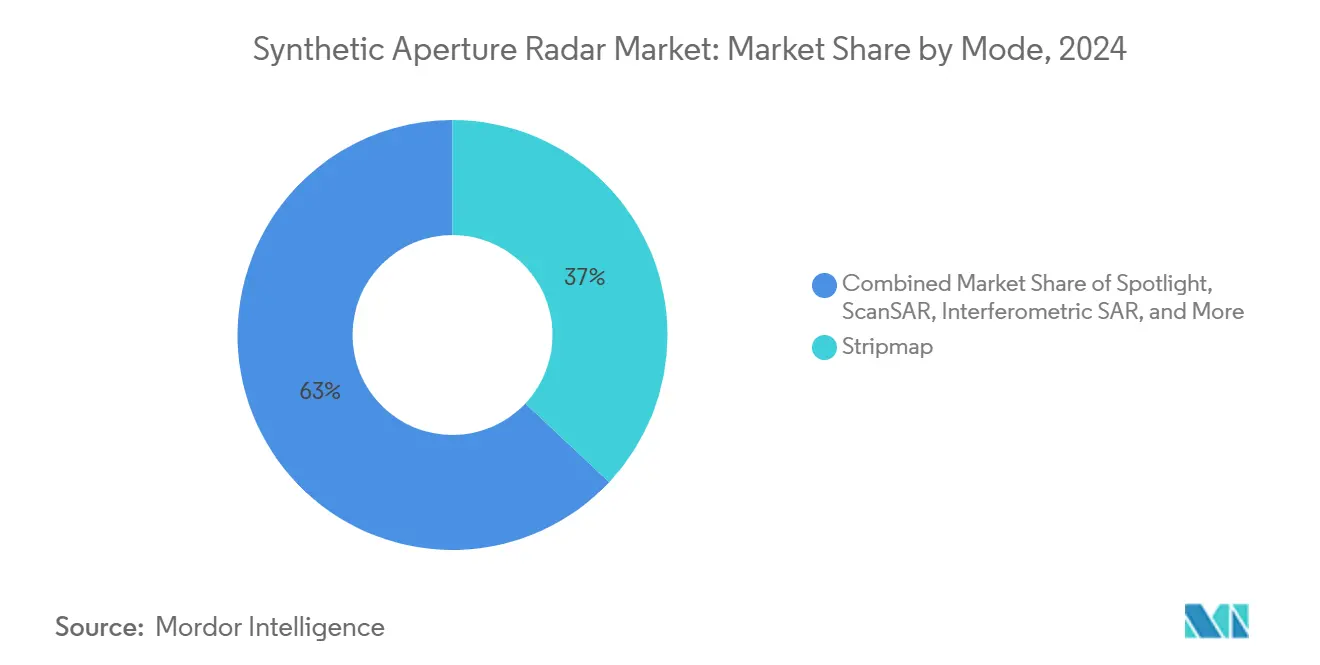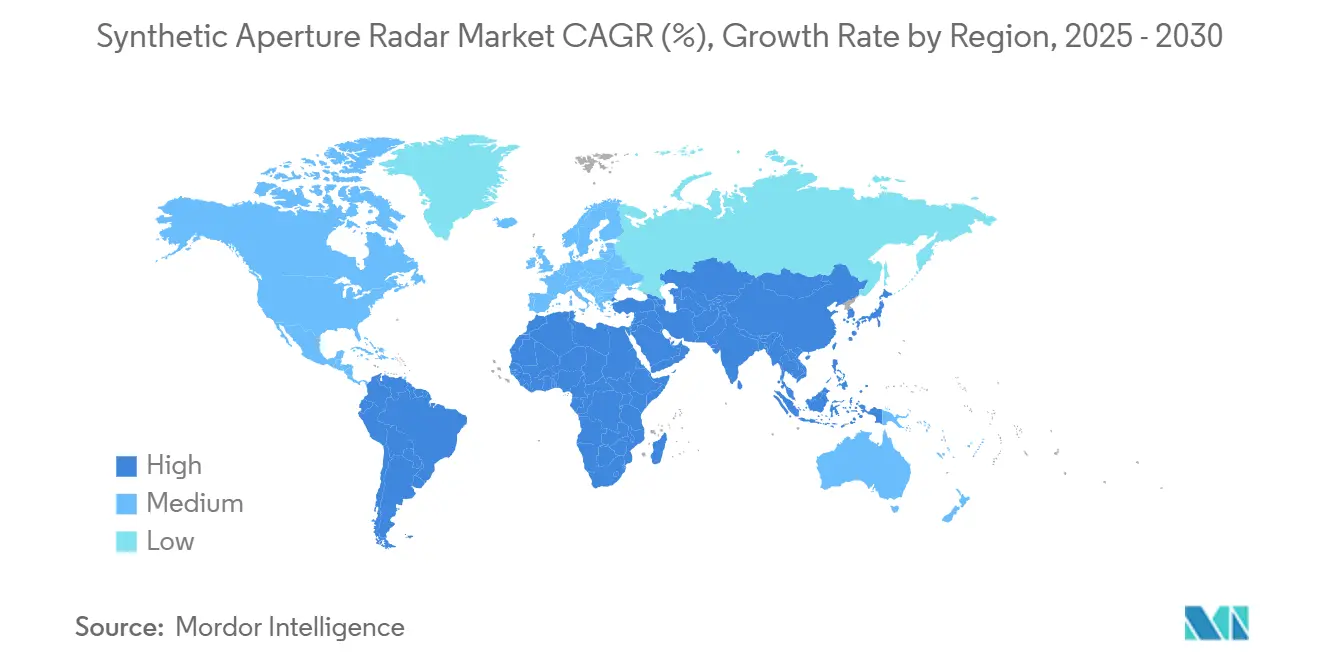Synthetic Aperture Radar Market Size and Share

Synthetic Aperture Radar Market Analysis by Mordor Intelligence
The synthetic aperture radar market size stands at USD 5.79 billion in 2025 and is projected to reach USD 9.88 billion by 2030, registering an 11.28% CAGR. Commercial demand is rising as all-weather imaging becomes essential for maritime safety, precision agriculture, and disaster response. Artificial intelligence is turning raw radar data into real-time decision support, while small-satellite constellations under 500 kg shorten revisit intervals to sub-30 minutes and cut deployment costs. Frequency diversification toward Ka-band mitigates X-band spectrum congestion and accelerates high-volume data downlinks, and software-defined payloads allow operators to switch imaging modes in orbit.
Key Report Takeaways
- By platform, Airborne systems retained a 54% synthetic aperture radar market share in 2024, whereas spaceborne small satellites are expected to expand at 13.3% CAGR through 2030.
- By frequency band, X-band led with 41% revenue share in 2024; Ka-band is forecast to grow at 13.6% CAGR to 2030.
- By component, Antenna hardware will account for 32% of the synthetic aperture radar market size in 2024, while data processors and analytics software will rise at a 13.9% CAGR by 2030.
- By mode, Stripmap claimed the highest 37% share, and interferometric SAR recorded the fastest 13.1% CAGR and is positioned to dominate infrastructure monitoring through 2030.
- By application, military and defence remains the largest user with a market share of 43% in 2024, while Earth Observation & Environmental Monitoring is the fastest-growing vertical with 12.7% CAGR.
- By geography, North America held 35% revenue in 2024; Asia-Pacific is on course for the strongest 12.4% CAGR to 2030, buoyed by China’s 26-billion-yuan pipeline of SAR programs.
Global Synthetic Aperture Radar Market Trends and Insights
Drivers Impact Analysis
| Driver | (~) % Impact on CAGR Forecast | Geographic Relevance | Impact Timeline |
|---|---|---|---|
| Increased defence-sector surveillance budgets | +2.8% | Global—North America, Europe, APAC clusters | Medium term (2-4 years) |
| Proliferation of small-satellite SAR constellations | +3.2% | North America & Europe leading; APAC scaling | Long term (≥ 4 years) |
| All-weather disaster-response imaging demand | +1.9% | Disaster-prone APAC and Americas | Short term (≤ 2 years) |
| AI-driven SAR analytics service models | +2.1% | North America & EU leadership; APAC acceleration | Medium term (2-4 years) |
| Source: Mordor Intelligence | |||
Increased Defence-Sector Surveillance Budgets
Escalating military expenditure anchors demand for persistent, high-resolution coverage. The U.S. Space Force set aside USD 4.7 billion for space procurement in fiscal 2024, channeling funds toward radar-enabled counterspace assets.[1]U.S. Air Force, “FY24 Space Force Procurement,” hq.af.milChina’s air-defence radar base reached USD 6 billion by 2022, extending strategic depth for multi-domain operations.[2]China Aerospace Studies Institute, “China's Air Defense Radar Industrial Base,” airuniversity.af.edu European programs such as Poland’s EUR 200 million (USD 216 million) multiyear order with ICEYE confirm steady procurement pipelines. Combined, these outlays guarantee baseline volumes for platform manufacturers and analytic service providers.
Proliferation of Small-Satellite SAR Constellations
Distributed fleets below 500 kg compress manufacturing cycles and slash launch charges, making revisit rates of 30 minutes economically viable. ICEYE’s 40-satellite fleet exemplifies the shift from monolithic spacecraft to scalable clusters. Total mission costs have fallen from USD 100 million for legacy birds to under USD 15 million for NewSpace units, catalyzing commercial entry.[3] German Aerospace Center, “NewSpace Synthetic Aperture Radar Instruments,” dlr.deJapan’s Synspective secured a 10-launch agreement with Rocket Lab for 2025-2027, underscoring investor confidence in rapid-cadence deployment.
All-Weather Disaster-Response Imaging Demand
Floods, wildfires, and landslides require penetration through cloud, smoke, and darkness. Bayesian workflows on Sentinel-1 time series consistently generate F1 scores above 0.4 for inundation mapping, demonstrating operational utility. Sentinel-1C’s 2024 launch added C-band capacity to relieve data bottlenecks during emergencies. Insurance carriers embed SAR-based damage verification to accelerate claims, turning post-event imagery into real-time loss estimates.
AI-Driven SAR Analytics Service Models
Software is shifting the synthetic aperture radar market toward subscription intelligence. ICEYE’s alliance with Safran.AI bundles 25 cm imagery with predictive algorithms to shorten tactical decision loops. Capella Space layered automated vessel detection onto its data portal, monetizing insights rather than pixels. Neural network denoising now removes speckle without ground truth, easing analyst workload.
Restraints Impact Analysis
| Restraint | (~) % Impact on CAGR Forecast | Geographic Relevance | Impact Timeline |
|---|---|---|---|
| High spaceborne SAR development & launch costs | −1.8% | Emerging markets, small operators worldwide | Medium term (2-4 years) |
| RF-spectrum congestion in X/C bands | −1.2% | North America and Europe | Long term (≥ 4 years) |
| Source: Mordor Intelligence | |||
High Spaceborne SAR Development & Launch Costs
Even with reusable launchers, capital requirements stay steep for precision radar payloads. Radiation-tolerant components, thermal control, and phased-array antennas drive bills upward, limiting new entrants that lack aerospace pedigree. Export-control approvals and cross-border frequency filings elongate project timelines, dampening cash-flow flexibility.
RF-Spectrum Congestion in X/C Bands
Dozens of public and private constellations crowd preferred microwave channels. Coordination overhead increases, forcing operators to adopt cumbersome interference-avoidance protocols or shift to Ka-band, which demands costly high-gain antennas and upgraded ground stations. Regulatory complexity risks longer licensing cycles and could defer revenue recognition.
Segment Analysis
By Platform: Small Satellites Drive Spaceborne Growth
Airborne assets capture highest share of 54% synthetic aperture radar market because defence agencies rely on flexible flight profiles and real-time crewed interpretation. Service providers combine manned aircraft with unmanned aerial vehicles for short-notice missions over restricted zones.
However, Spaceborne systems have shifted from a handful of multiton assets to proliferated clusters, enabling faster coverage without heavy infrastructure. Spaceborne systems record a 13.3% CAGR, making them the standout contributor to future synthetic aperture radar market size. ICEYE’s Gen-4 units with 1 200 MHz bandwidth achieve 25 cm resolution, matching larger craft at a fraction of cost. Distributed risk across many low-cost spacecraft also improves constellation resiliency against orbital debris and anti-satellite threats.

Note: Segment shares of all individual segments available upon report purchase
By Frequency Band: Ka-Band Emerges Despite X-Band Dominance
X-band maintains 41% revenue share, favored by militaries for fine-scale mapping in varied weather. Established supply chains streamline payload procurement, reinforcing incumbency. C-band remains central for agriculture and climate surveillance through the Sentinel-1 fleet.
Ka-band’s 13.6% CAGR reflects its ability to transmit 26 Tb of daily data, supporting real-time analytics that expand the synthetic aperture radar market. Higher frequencies reduce spectrum congestion but obligate advanced thermal designs and steerable antennas. Emerging Ku-band platforms promise mid-cost, high-throughput links for commercial imaging.
By Component: Software Acceleration Outpaces Hardware
Antenna subsystems held 32% synthetic aperture radar market size in 2024 because beam steering defines resolution and swath width. Digital beamforming increases gain without mechanical motion, prolonging mission life.
Processing chipsets and analytics software are on track for 13.9% CAGR as operators embed edge computing to compress downlink loads. NASA’s Signals-of-Opportunity prototype demonstrates SAR on a power budget small enough for CubeSats, underscoring demand for efficient signal chains. Application-specific ICs offer reliability advantages versus traditional FPGAs, signaling a long-term pivot to purpose-built silicon.
By Mode: Interferometric Applications Lead Innovation
Stripmap claimed a 37% share due to consistent coverage for routine defence reconnaissance. Spotlight delivers sub-meter resolution for target identification, but dwell time limits coverage.
Interferometric operations record the highest 13.1% CAGR as utilities and municipalities monitor bridges, tunnels, and rail lines for millimetric subsidence. Machine-learning integration improves coherence across multi-satellite stacks, giving infrastructure owners predictive maintenance tools.[4]The Egyptian Journal of Remote Sensing and Space Sciences, “Machine Learning-Based Multi-Satellite SAR Integration,” sciencedirect.comScanSAR supplements disaster relief with wide-area sweeps, while polarimetric modes enhance material classification accuracy.

Note: Segment shares of all individual segments available upon report purchase
By Application: Defence Drives While Environmental Monitoring Accelerates
Military & Defence remains the largest user with a market share of 43% in 2024, while exploiting penetration through camouflage and anti-jamming robustness. Capella Space’s USD 15 million U.S. Air Force contract for dual-polarization sensors underscores strategic value.
Earth Observation & Environmental Monitoring is the fastest-growing vertical with 12.7% CAGR., as regulators mandate proof of carbon-offset projects and early warning for floods. DInSAR techniques flag pipeline threats in UNESCO-protected forests, helping energy firms avoid costly spills. Agriculture analysts apply SAR flood maps to estimate paddy crop losses, supporting disaster-relief subsidies.
Geography Analysis
North America led the synthetic aperture radar market in 2024 with 35% revenue, underpinned by NASA technology budgets and deep defence procurement. The FY 2026 request allocates USD 72.1 million to the NISAR mission, ensuring domestic demand for payload integrators and analytics firms. Commercial vendors such as Capella Space and Umbra Space benefit from a robust venture-capital ecosystem, while Canada uses RADARSAT derivatives for Arctic and resource surveillance.
Asia-Pacific exhibits the fastest 12.4% CAGR, driven by China’s 26-billion-yuan order book that positions the region to eclipse North American volume by 2030. Beijing-based Weina Star’s RMB 8.04 billion constellation contract signals long-term industrialization of SAR manufacturing. Japan’s Synspective raised JPY 7 billion (USD 47 million) in Series C and aligned with Mitsubishi Electric, Toyoda Gosei, and IHI to co-develop payloads, reinforcing local supply chains. India’s domestic electronics output touched INR 9.52 lakh crore (USD 115 billion), laying the groundwork for indigenous component sourcing. South Korea’s ASIC roadmap targets radiation-hardened chipsets to secure export contracts.
Europe retains steady momentum via the Copernicus program and defence collaboration. Sentinel-1C’s 2024 launch guarantees continuity of C-band data, while ICEYE’s German joint venture with anchors sovereign production capacity Rheinmetall. ICEYE has also opened regional hubs in Greece, enabling EU governments to comply with strategic autonomy objectives.
The Middle East and Africa are nascent but active. UAE’s first SAR satellite, Foresight-1, coupled with Space42’s manufacturing partnership with ICEYE, illustrates a regional pivot from satellite import to local build-to-print capability. African states evaluate SAR for natural-resource oversight and border security, although budget limits will temper short-term uptake.

Competitive Landscape
The synthetic aperture radar market features moderate concentration: the five largest players capture around 40% global revenue yet face disruptive pressure from venture-backed entrants. Established aerospace groups employ vertical integration to defend share, bundling hardware, proprietary processing chains, and turnkey analytics into multiyear contracts. Lock-in increases switching costs for government customers who value assured supply and secure data pipelines.
Specialized players such as ICEYE scale via volume manufacturing of compact satellites and “imaging-as-a-service” commercial models. Partnerships with defence primes—exemplified by Rheinmetall ICEYE Space Solutions—give them access to classified markets without expensive independent certification. Patent filings on formation-flying SAR and coherent multistatic processing indicate investment in intellectual-property moats.
Emerging challengers focus on application-layer value. Capella Space layers AI vessel detection, Umbra experiments with synthetic GNSS reflectometry, and Synspective pursues urban analytics for smart-city investors. Large-scale corporate buyers increasingly demand APIs rather than raw data, shifting competitive leverage toward firms that offer actionable insights with service-level guarantees.
Synthetic Aperture Radar Industry Leaders
-
Lockheed Martin Corporation
-
Airbus SE
-
Aselsan A.S.
-
BAE Systems PLC
-
Cobham PLC
- *Disclaimer: Major Players sorted in no particular order

Recent Industry Developments
- May 2025: ICEYE and Safran formed an AI-centric alliance to blend 25 cm radar imagery with multisensor analytics, targeting faster strategic decision cycles for governmental clients
- May 2025: Rheinmetall ICEYE Space Solutions launched to domestically manufacture SAR satellites in Germany from Q2 2026, reinforcing supply-chain sovereignty
- May 2025: IHI Corporation signed an MoU with ICEYE for a 24-satellite constellation, broadening Japan’s autonomous imaging network.
- January 2025: ICEYE added two mid-inclination satellites on SpaceX Bandwagon-2, pushing its constellation to 40 units.
Research Methodology Framework and Report Scope
Market Definitions and Key Coverage
Our study defines the synthetic aperture radar (SAR) market as all new airborne and spaceborne imaging radar systems, their payload hardware, and the enabling ground-segment software and processing electronics that together deliver two- or three-dimensional radar imagery for defense, civil, and commercial users. According to Mordor Intelligence, the market was valued at USD 5.79 billion in 2025 and is projected to reach roughly USD 9.9 billion by 2030, reflecting an 11.3 percent compound annual growth rate.
Scope exclusion: terrestrial fixed-site perimeter radars and purely passive radar data-analytics services are outside this study.
Segmentation Overview
- By Platform
- Airborne SAR
- Manned Aircraft
- UAV
- Spaceborne SAR
- Small Satellites (≤500 kg)
- Large Satellites (>500 kg)
- Ground-based SAR
- Maritime-based SAR
- Airborne SAR
- By Frequency Band
- X-Band
- L-Band
- C-Band
- S-Band
- Ku-Band
- Ka-Band
- Others (P, VHF, UHF)
- By Component
- Antenna
- Transmitter
- Receiver
- Data Processor and Software
- Power Supply
- Others
- By Mode
- Stripmap
- Spotlight
- ScanSAR (Wide-Swath)
- Interferometric SAR (InSAR)
- Polarimetric SAR (PolSAR)
- By Application
- Military and Defence
- Earth Observation and Environmental Monitoring
- Oil and Gas Exploration
- Infrastructure Monitoring
- Maritime Surveillance
- Disaster Management and Agriculture
- Other Applications
- By Geography
- North America
- United States
- Canada
- Mexico
- South America
- Brazil
- Argentina
- Rest of South America
- Europe
- Germany
- United Kingdom
- France
- Italy
- Spain
- Russia
- Rest of Europe
- APAC
- China
- Japan
- India
- South Korea
- Australia and New Zealand
- Southeast Asia
- Rest of APAC
- Middle East and Africa
- Middle East
- Saudi Arabia
- UAE
- Turkey
- Israel
- Rest of Middle East
- Africa
- South Africa
- Nigeria
- Egypt
- Rest of Africa
- Middle East
- North America
Detailed Research Methodology and Data Validation
Primary Research
Mordor analysts interviewed radar engineers at satellite manufacturers, procurement officers within defense ministries, and commercial geospatial-analytics buyers across North America, Europe, and Asia Pacific. Discussions validated average selling prices, typical satellite bus mass classes, constellation replenishment cycles, and emergent demand signals not captured in desk research.
Desk Research
We began with open data streams such as the United Nations launch registry, the European Space Agency's Copernicus archives, NASA's Earth Observatory missions, International Telecommunication Union filings on spectrum assignments, and Stockholm International Peace Research Institute defense-spending tables, which supply counts of satellites, imaging hours, program budgets, and regulatory milestones. Company 10-Ks, investor decks, and trade-association white papers round out pricing and procurement patterns. Paid intelligence from D&B Hoovers and Aviation Week provided revenue splits and production run insights for key SAR platform builders. These sources anchor historical baselines and cross-check each other; however, they are illustrative, not exhaustive, and many additional references inform our files.
Market-Sizing & Forecasting
A top-down reconstruction based on annual satellite launches, average payload cost, and unit shipment data created the initial market pool, which is then corroborated with selective bottom-up supplier roll-ups for antennas, transmit-receive modules, and onboard processors. Core variables inside our model include small-satellite launch counts, defense ISR budget growth, commercial imagery subscription revenues, mean payload mass to power ratios, and frequency-band mix shifts. Multivariate regression, guided by expert consensus, links these drivers to revenue trajectories, while gap-handling rules distribute unreported volumes proportionally across known vendors.
Data Validation & Update Cycle
Each draft output is stress tested through variance checks against independent capacity trackers and ASP benchmarks, followed by a two-step analyst review. The dataset refreshes annually, and interim updates are triggered when launch manifests, contract wins, or material regulatory rulings change the underlying assumptions.
Why Mordor's Synthetic Aperture Radar Market Baseline Commands Reliability
Published SAR figures often diverge because studies vary in platform coverage, currency conversion timing, and refresh cadence.
By selecting only platforms that carry imaging payloads and by revisiting key variables every twelve months, we keep our baseline tightly aligned with real delivery schedules.
Key gap drivers with other publishers include inclusion of ground radars, omission of small-satellite discounting, and the use of flat price escalators rather than cost-curve-based ASPs.
Benchmark comparison
| Market Size | Anonymized source | Primary gap driver |
|---|---|---|
| USD 5.79 B (2025) | Mordor Intelligence | - |
| USD 5.39 B (2024) | Global Consultancy A | Excludes processing software; applies higher future ASP uplift |
| USD 5.42 B (2024) | Industry Association B | Counts ground surveillance radars within scope |
| USD 4.65 B (2024) | Regional Consultancy C | Uses production units only, no services revenue |
Taken together, the comparison shows that Mordor's disciplined scope definition, variable selection, and yearly refresh provide a balanced and repeatable baseline that decision makers can rely upon when sizing opportunities or benchmarking performance.
Key Questions Answered in the Report
What is the growth outlook for the synthetic aperture radar market through 2030?
The synthetic aperture radar market size is projected to rise from USD 5.79 billion in 2025 to USD 9.88 billion by 2030, reflecting an 11.28% CAGR.
Which platform segment is expanding the fastest?
Spaceborne small satellites below 500 kg are forecast to grow at 13.3% CAGR, driven by low manufacturing costs and sub-hourly revisit rates.
Why is Ka-band gaining traction in new SAR missions?
Ka-band supports 26 Tb daily data throughput, easing spectrum congestion and enabling rapid delivery of high-resolution imagery to end-users.
How are defence budgets shaping demand?
Multi-billion-dollar allocations by the U.S. and allied forces prioritize persistent intelligence, securing predictable revenue for SAR satellite and analytics suppliers.
What role does artificial intelligence play in SAR adoption?
AI automates speckle reduction, object detection, and change analysis, transforming raw images into actionable insights and underpinning SAR-as-a-Service business models.
Is the market fragmented or consolidated?
With the top five players holding close to 40% revenue, the market is moderately concentrated, offering both scale benefits for leaders and entry points for agile start-ups.
Page last updated on:



